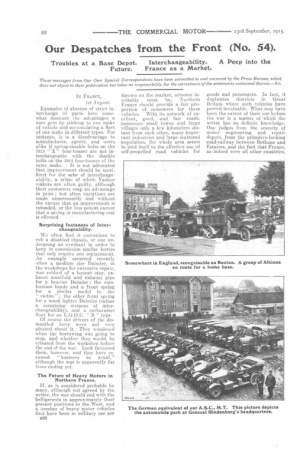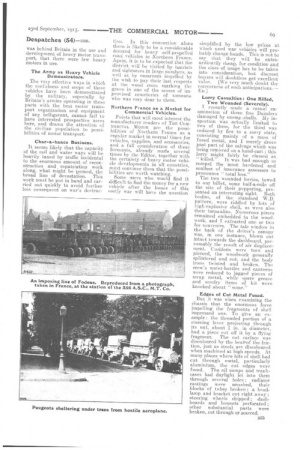Our Despatches from the Front (No. 54).
Page 8

Page 9

If you've noticed an error in this article please click here to report it so we can fix it.
Troubles at a Base Depot. Interchangeability. A Peep into the Future. France as a Market.
These messages from Our Own Special Correspondents have been submitted to and censored by the Press Bureau, which does not object to their publication but takes no responsibility for the correctness of the statements contained therein.—ED.
IN FRANcE, 1st Aug list.
Examples of absence of strict interchange of parts here somewhat discount the advantages a user gets by sticking to one, make of vehicle and acettinulating a fleet of one make in different types. For instance, it is a disadvantage to manufacturer, agents, and users alike if spring-shackle bolts on the 1913 " X four-tanner are not interchangeable with the shackle bolts on the 1914 four-tonner of the same make. It is not. advocated that improvement should be sacrificed for the sake of interchange ability, a crifne of which Yankee makers are often guilty, although their customers reap an advantage in price ; but often variations are made unnecessarily and without the excuse that an improvement is intended, or the less potent excuse that a saving in manufacturing cost
is effected.
Surprising Instances of Interchangeability.
We often find it convenient to roba disabled chassis, or one undergoing an overhaul in order to keep in commission similar lorries that only require one replacement. An example occurred recently when a medium size, Daimler, in the workshops for extensive repair, was robbed of a bonnet stay, exhaust manifold and exhaust pipe for a heavier Daimler ; the combustion heads and a front spring for a similar model to the " victim" ; the other front spring for a much lighter Daimler (rather a surprising instance of interchangeability), and a carburetter float for an L.G.O.C. " B" type.
Of course the drivers of the dismantled lorry were not very pleased about it. They wondered when the borrowing was going to stop, and whether they would be released from the workshop before the end of the war. Luck favoured them, however, and they have resumed " business as usual," although the war is apparently far from ending yet..
The Future of Heavy Motors in Northern France.
If, as is considered probable by many, although not agreed by the writer, the war should end with the belligerents in approximately their present positions in the West, and a number of heavy motor vehicles that have -been in military use. are
B30
thrown on the market, aglsorne inevitably must be, Northern France should provide a fair proportion of customers for these vehicles. With its network of excellent, good, and fair roads, numerous small towns and large villages only a few kilometres distant from each other, many important industries and large scattered population, the whole area seems to lend itself to the effective use of self-propelled road vehicles for goods and passengers. In fact,.it duplicates districts in Great Britain. where such vehicles have proved invaluable. What may have been the extent of their use before the war is a matter of which the writer has no definite knowledge. One judges from the scarcity ..of motor engineering and repair depots, from the primitive-looking road-railway between Bethune and Estaires, and the fact that France; as indeed were all other countries,
was behind Britain in the use and development of heavy motor transport, that there were few heavy Motors in use.
The Army as Heavy Vehicle Demonstrators.
The very effective ways in which the usefulness and scope of these vehicles have been demonstrated by the military, especially by Britain's armies operating in these parts with the best motor transport organization and equipment of any belligerent, cannot fail to have interested prospective users here, and drawn the attention of the civilian population to possibilities of motor transport.
Char-a..bancs Business.
It seems likely that the capacity of the rail and water ways will be heavily taxed by traffic incidental to the enormous amount of reconstruction and repatriation work along, what might be termed, the broad line of de.vastation. This work must be put in hand and carried out quickly to avoid further loss consequent on war's destruc tion. In this connection alone there is likely to be a considerable demand for heavy self-propelled road vehicles in Northern France. Again, it is to be expected that the district will be visited by tourists and sightseers in large numbers, as well as by mourners impelled by the wish to pay their last respects at the wood cross marking the grave in one of the scores of improvised cemeteries of . someone who was very dear to them.
Northern France as a Market for Commercial Vehicles.
Points that will most interest the manufacturer readers of THE COIVIAIERCIAL MOTOR Are the possibilities of Northern France as a regular market in normal times for vehicles, supplies, and accessories, and a full consideration of these forecasts, already made several times by the Editor, together with the certainty of heavy motor vehicle developments, in all 'countries, must, convince them that the possi, bilities are worth watching.
Some users who would find it difficult to find the money for a new vehicle after the losses of this costly war will have the question" simplified by the low priees at which used war vehicles will probably change hands. This is not to say that they will be extraordinarily cheap, for condition and the class of .usage has to be taken into consideration, but discreet buyers will doubtless get excellent value. [We very much doubt the correctness of such anticipations.— En.] Lorry Casualties : Ong Killed, Two Wounded (Severely).
I recently made a casual examination of three fine Daimlers damaged by enemy ,shells. My inspection was actually limited to two of them, for the third was reduced by fire to a sorry state, consisting mainly of a. mass of fused metal, and I merely drove past part of the salvage which was being removed on a hand-cart ; this lorry might fairly be classed as " killed." It was bad enough to compel the most hardened and Soulless of insurance assessors to pronounce " total loss."
The two wounded lorries, towed to our billet, some half-a-mile off the site of their peppering, pmsented an interesting sight. Both bodies, of the standard W.D, pattern, were riddled by bits of high-explosive shell, as were also their tarpaulins. Numerous pieces remained embedded in the woodwork, and T. extracted one or two for souvenirs. The tale window in the back of the driver's canopy was, in one instance, blown out intact towards the dashboard, presumably the result of air displaee nient. Cushions were torn and pierced, the woodwork generally splintered and cut, and the body irons twisted and broken. The crew's water-bottles and canteens were reduced to jagged pieces of scrap metal, while spare grease and sundry items of kit were knocked about "some."
Edges of Cut Metal Fused.
But it was when examining the chassis that the enormous force impelling the fragments of shell impressed one. To give an example : the threaded portion of a steering lever projecting through its nut, about in. in diameter, had a piece cut off it by a ftying fragment. The cut surface was discoloured by the heatctof the friction, just as steels are discoloured when machined at high speeds. At many places where bits of shell had cut through metal, particularly aluminium, the cut edges were fused. The oil .sumps and crankcases had daylight let into them through several holes ; radiator castings were smashed, their blocks of tube broken ; a headlamp and bracket cut right away ; steering wheels chipped: dashboards and bonnets perforated ; other substantial parts were broken, cut through or scarred.




















